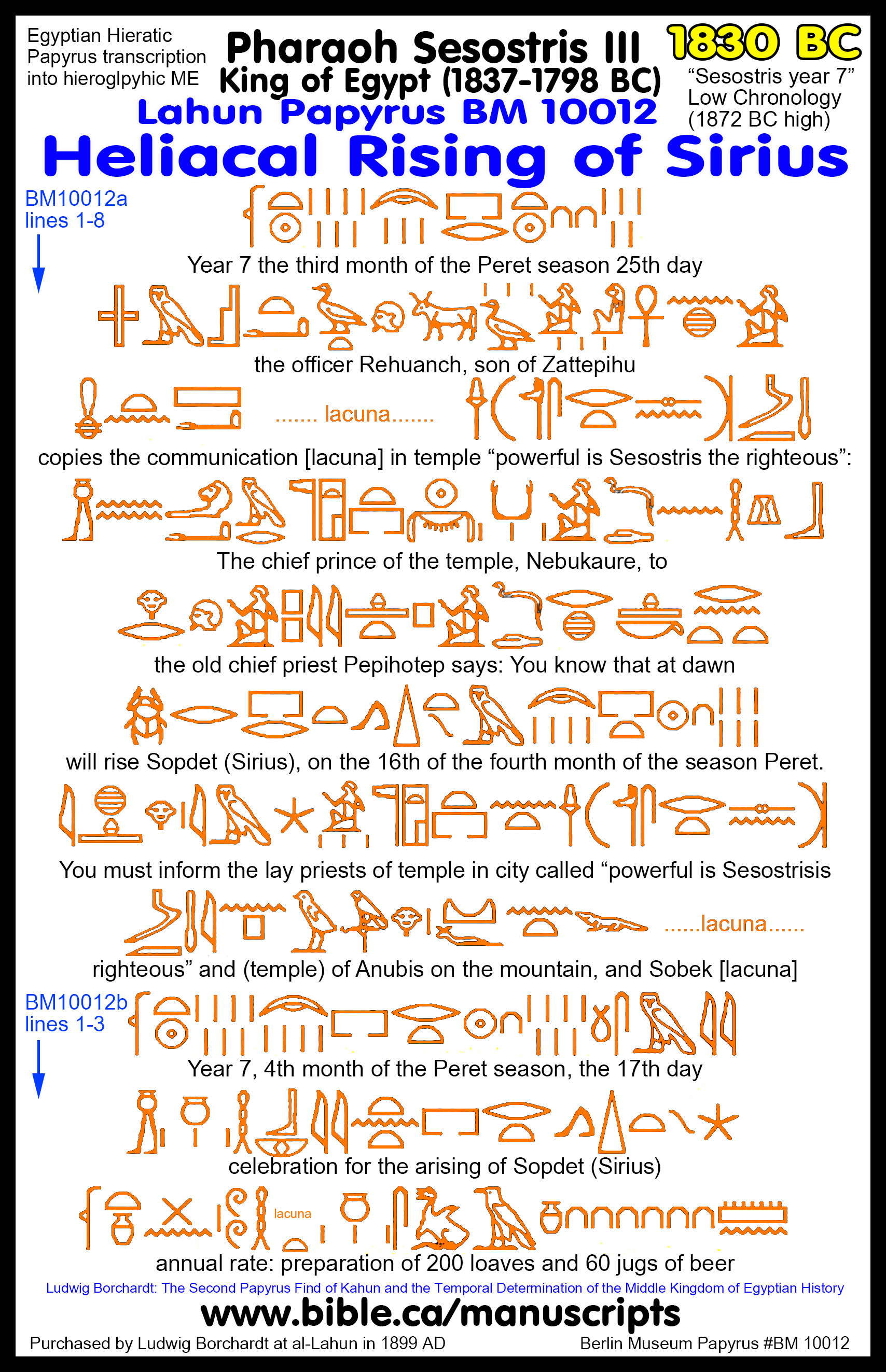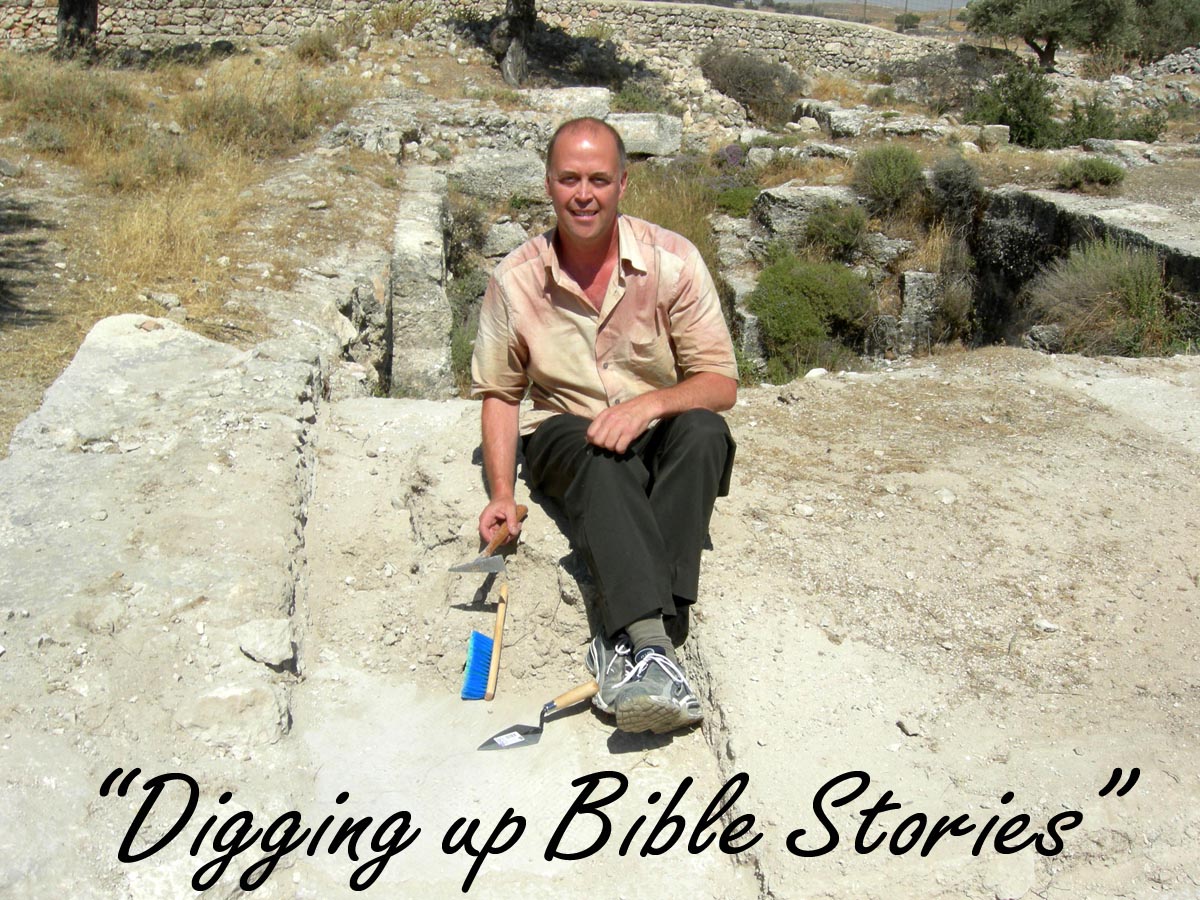BM 10012
El-Lahun Berlin Museum Papyrus 10012a,b
12th Dynasty, Year 7 of Pharaoh Sesostris III
Heliacal rising of Sirius (Sobek)
Egyptian Chronology: 1830 BC
|
Digging up Bible stories! One of the most important documents for Egyptian chronology ever discovered because it connects the Year 7 of Pharaoh Sesostris III with the heliacal rising of Sirius. Egyptian chronology is lost without the Bible and we are able to align the 12th dynasty pharaohs to the story of Joseph in Egypt. BM 10012 was purchased by Ludwig Borchardt at al-Lahun in 1899 AD. Written in Egyptian Hieratic on both sides of the papyrus (BM 10012a, BM 10012b).
"What we read in the book, we find in the ground" |
Introduction:
- One of the most important documents for Egyptian chronology ever discovered because it connects the Year 7 of Pharaoh Sesostris III with the heliacal rising of the dog-star “Sirius”.
- Egyptian chronology is lost without the Bible and we are able to align the 12th dynasty pharaohs to the story of Joseph in Egypt. BM 10012 was purchased by Ludwig Borchardt at al-Lahun in 1899 AD.
- We are able to now determine that the Dreaming pharaoh of Joseph, who interpreted the dream was for pharaoh
- “Year 7 of Sesostris III Sirius arises” (BM 10012)
- Written in Egyptian Hieratic on both sides of the papyrus
- Front side: BM 10012a
- Reverse side: BM 10012b
I. Translation of BM 10012:
2. “It is the mayor and dean of the temple Nubkhaure who addresses the chief lector priest Pepyhotep: I am speaking in order for you to know that it is on the sixteenth day of the fourth month of the second season that the heliacal rising of Sothis (Sirius) will occur. May the attention of the priestly corps of the mortuary temple “Powerful is Senwosret/Sesostris (II), the deceased,” of Anubis who is upon his mountain, and of Sobek be directed thereto. And have this letter entered into the journal of the temple.” (Letters from ancient Egypt, E. F., Wente, E. S. Meltzer, Vol 1, #84, P. Berlin 10012, 18–21, 1990 AD)
3. Ludwig Borchardt: The Second Papyrus Find of Kahun and the Temporal Determination of the Middle Kingdom of Egyptian History
|
BM 1002a: Lines 1-8 |
1. “Year 7 the third month of the Peret season 25th day 2. the officer Rehuanch, son of Zattepihu 3. copies the communication [lacuna] in the temple “powerful is Sesostris the righteous”: 4. The chief prince of the temple, Nebukaure, to 5. the old chief priest Pepihotep says: You know that at dawn 6. will rise Sopdet (Sirius), on the 16th of the fourth month of the season Peret. 7. You must inform the lay priests of the temple of the city called “powerful is Sesostrisis 8. righteous” and (of the temple) of Anubis that is on the mountain, and of Sobek [lacuna]” |
|
BM 1002b Lines 1-3
|
1. “Year 7, 4th month of the Peret season, the 17th day 2. celebration for the arising of Sopdet (Sirus) 3. annual rate: preparation of 200 loaves and 60 jugs of beer” |
II. Discussion regarding Egyptian Low chronology vs High chronology:
|
Egyptian Chronology of the 12th Dynasty Pharaohs |
||
|
|
High Chronology: 1979-1801 (R. A. Parker, D. Petrovich) |
Low Chronology: 1937-1759 (High - 42 years) K. A. Kitchen, O. Keel) |
|
Amenemhat I (29) |
1979-1950 |
1937-1908 |
|
Sesostris I (44) |
1960-1916 |
1918-1874 |
|
Amenemhat II (35) |
1919-1884 |
1877-1842 |
|
Sesostris II (9) |
1887-1878 |
1845-1836 |
|
Sesostris III (38) |
1878-1840 7th = 1872 |
1836-1798 7th = 1830 |
|
Amenemhat III (46) |
1859-1813 |
1817-1771 |
|
Amenemhat IV (9) |
1814-1805 |
1872-1763 |
|
Sobekneferu (4) |
1805-1801 |
1763-1759 |
1. This “low chronology” follows K. A. Kitchen and O. Keel. Papyrus Berlin BM 10012 marks the heliacal rising of Sothis (Sirius) on year 7 of Sesostris III which dates to 1830 BC.
a. Douglas Petrovich PhD follows the high chronology which gives a date of 1872 BC.
b. The difference in low/high is based upon the assumption of where the heliacal rising was observed from: Memphis/Lahun (high) vs. Elephantine (low).
2. “Egyptian chronology for the second millennium has experienced a similar trend. For the New Kingdom, Rainey describes high and low chronologies that differ by 25 years. For example, the reign of Thutmose III started at either 1504 or 1479 B.C. (Rainey 1999: 60). More recently, Bietak and Höflmayer (2007: 14) have described the variance for the New Kingdom as amounting to about 10 years, with its start around 1550–1540 B.C. However, they also acknowledge that there is a maximum 20-year flexibility in either direction before the pressure on genealogies and reign lengths would become too much, so that the outside range really begins about 1570 B.C. and ends about 1520 B.C. Thus, for example, the New Encyclopedia of Archaeological Excavations in the Holy Land (Stern ed. 1993: 1530) begins the New Kingdom at 1570 B.C., while Baines and Malek (2000: 36) start it at 1520 B.C. In effect, then, there exists a 50-year window. Bietak and Höflmayer (2007: 15) prefer the lower end of this range, placing the start of the New Kingdom at about 1530 B.C. Kitchen (2007: 170) agrees, beginning the New Kingdom at 1540/30 B.C.” (Has Radiocarbon Artificially Raised Bronze Age Dates?, K. J. Udd The Near East Archaeological Society Bulletin, 58, p1, 2013)
3. “Since agreement has not been reached on the start of the New Kingdom, it is no wonder that dates for the earlier Middle Kingdom are also uncertain. Kitchen (1987: 47) has demonstrated that there are at least high and low possibilities for the Middle Kingdom, differing according to his estimate by 42 years. Amenemhet I, the first king of Dynasty 12, could thus be estimated to have begun his reign as early as 1979 B.C. or as late as 1937 B.C. (Kitchen 1987: 49). Twenty years later, the same difference of 42 years was again referenced by Bietak and Höflmayer (2007: 14) in their review of high and low chronologies, an indication that little progress has been made. In practice, the gap may be even wider. Baines and Malek (2000: 36) employ a date very similar to Kitchen’s low chronology—1938 B.C. for the start of Dynasty 12, whereas Aldred (1998: 215) advocates a date even higher than Kitchen’s high date of 1979 B.C., choosing 1994 B.C. for the start of Dynasty 12. This amounts to a difference of about 56 years. Kitchen (2000: 46) has also observed that the length of the 12th Dynasty itself has shrunk over the past half decade, from 205 years to only 178 years.” (Has Radiocarbon Artificially Raised Bronze Age Dates?, K. J. Udd The Near East Archaeological Society Bulletin, 58, p3, 2013)
By Steve Rudd: Contact the author for comments, input or corrections.



